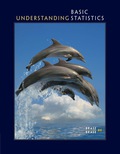
Concept explainers
Unifrom Distribution: Measurement Errors Measurement errors from instruments are often modeled using the uniform distribution (see Problem 12). To determine the
(a) less than +0.03 microsecond
(c) between -0.04 and +0.01 microsecond?
(d) Find the
(a)
To find: Theprobability thatsuch measurements will be in error byless than 0.03 microseconds.
Answer to Problem 13P
Solution: Theprobability that such measurements will be in error byless than 0.03 microsecondsis0.8.
Explanation of Solution
Calculation:
Let
Let x is chosen at random from [
We have to find the probability of less than 0.03 microseconds,
Hence,
(b)
To find: Theprobability thatsuch measurements will be in error bymore than -0.02 microseconds.
Answer to Problem 13P
Solution: Theprobability that such measurements will be in error by more than -0.02 microsecondsis0.7.
Explanation of Solution
Calculation:
Let
Let x is chosen at random from [
We have to find the probability of more than -0.02 microseconds,
Hence,
(c)
To find: Theprobability thatsuch measurements will be in error bybetween -0.04 and 0.01 microseconds.
Answer to Problem 13P
Solution: Theprobability that such measurements will be in error bybetween -0.04 and 0.01 microsecondsis0.5.
Explanation of Solution
Calculation:
Let
Let x is chosen at random from [
We have to find the probability between -0.04 and 0.01 microseconds,
Hence,
(d)
To find: Themean and standard deviation of measurement errors and whether the measurements for these acoustical sensors are unbiased.
Answer to Problem 13P
Solution:
The mean of measurement errors is 0. The standard deviation of measurement errors is 0.029. Yes, the measurements for these acoustical sensors are unbiased.
Explanation of Solution
Calculation:
Let
We have to find the mean,
Therefore, the mean is 0 microsecond.
We have to find the standard deviation,
Therefore, thestandard deviationis 0.029microsecond.
Yes, since the obtained mean of the measurement errors is zero so the measurements for these acoustical sensors are unbiased.
Want to see more full solutions like this?
Chapter 7 Solutions
Understanding Basic Statistics
- Harvard University California Institute of Technology Massachusetts Institute of Technology Stanford University Princeton University University of Cambridge University of Oxford University of California, Berkeley Imperial College London Yale University University of California, Los Angeles University of Chicago Johns Hopkins University Cornell University ETH Zurich University of Michigan University of Toronto Columbia University University of Pennsylvania Carnegie Mellon University University of Hong Kong University College London University of Washington Duke University Northwestern University University of Tokyo Georgia Institute of Technology Pohang University of Science and Technology University of California, Santa Barbara University of British Columbia University of North Carolina at Chapel Hill University of California, San Diego University of Illinois at Urbana-Champaign National University of Singapore McGill…arrow_forwardName Harvard University California Institute of Technology Massachusetts Institute of Technology Stanford University Princeton University University of Cambridge University of Oxford University of California, Berkeley Imperial College London Yale University University of California, Los Angeles University of Chicago Johns Hopkins University Cornell University ETH Zurich University of Michigan University of Toronto Columbia University University of Pennsylvania Carnegie Mellon University University of Hong Kong University College London University of Washington Duke University Northwestern University University of Tokyo Georgia Institute of Technology Pohang University of Science and Technology University of California, Santa Barbara University of British Columbia University of North Carolina at Chapel Hill University of California, San Diego University of Illinois at Urbana-Champaign National University of Singapore…arrow_forwardA company found that the daily sales revenue of its flagship product follows a normal distribution with a mean of $4500 and a standard deviation of $450. The company defines a "high-sales day" that is, any day with sales exceeding $4800. please provide a step by step on how to get the answers in excel Q: What percentage of days can the company expect to have "high-sales days" or sales greater than $4800? Q: What is the sales revenue threshold for the bottom 10% of days? (please note that 10% refers to the probability/area under bell curve towards the lower tail of bell curve) Provide answers in the yellow cellsarrow_forward
- Find the critical value for a left-tailed test using the F distribution with a 0.025, degrees of freedom in the numerator=12, and degrees of freedom in the denominator = 50. A portion of the table of critical values of the F-distribution is provided. Click the icon to view the partial table of critical values of the F-distribution. What is the critical value? (Round to two decimal places as needed.)arrow_forwardA retail store manager claims that the average daily sales of the store are $1,500. You aim to test whether the actual average daily sales differ significantly from this claimed value. You can provide your answer by inserting a text box and the answer must include: Null hypothesis, Alternative hypothesis, Show answer (output table/summary table), and Conclusion based on the P value. Showing the calculation is a must. If calculation is missing,so please provide a step by step on the answers Numerical answers in the yellow cellsarrow_forwardShow all workarrow_forward
 Mathematics For Machine TechnologyAdvanced MathISBN:9781337798310Author:Peterson, John.Publisher:Cengage Learning,
Mathematics For Machine TechnologyAdvanced MathISBN:9781337798310Author:Peterson, John.Publisher:Cengage Learning, Glencoe Algebra 1, Student Edition, 9780079039897...AlgebraISBN:9780079039897Author:CarterPublisher:McGraw Hill
Glencoe Algebra 1, Student Edition, 9780079039897...AlgebraISBN:9780079039897Author:CarterPublisher:McGraw Hill

